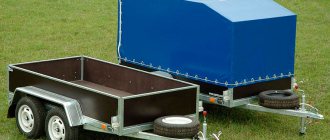How does 2021 legislation regulate tire differentials?
There are 2 legal acts regulating the rules for installing tires on a car:
- Traffic rules and their List of faults (appendix to the Rules) - regulate the conditions when driving a car is prohibited: different tread patterns, different types of tires on different axles of the vehicle and other rules,
- Technical regulations on the safety of wheeled vehicles - this legal act already prescribes regulations for the completeness of vehicles on this issue and concerns more directly the equipment of the vehicle rather than its management.
In our case, the traffic rules will be quite sufficient. This document specifies 2 subtleties of installation:
- different tires on different axles of the car: in front there is a pair of identical tires and in the rear there is a pair identical to each other, but different from those in front,
- unequal tires on the same axle of the car: one on the left, another on the right, front and rear.
But the main subtlety is that the driver is prohibited from operating the car according to traffic regulations. Operation involves driving and controlling the vehicle. Therefore, according to the letter of the law, you can install any combination of tires on your vehicle. It’s just that you are prohibited from driving such a car in certain combinations.
So, let's look at the question of which different tires are not allowed and which ones can be placed on the wheels of a car, and at the end of this article we will provide a summary table.
New pair for rear axle
If you still buy two new tires, it is best if they are the same model and in the same size. Moreover, a new pair of tires must be installed on the rear axle of the car. This choice is due to the fact that new tires grip the road better and drain water better.
Owners of front-wheel drive cars may object: they say, new tires on the front will give better acceleration and braking. However, this opinion will change in an emergency situation, when new front tires will allow you to avoid losing steering, while the worn rear tires will lose traction. And if you can cope with the skidding of the front axle thanks to the steering, then either a driver with extreme driving experience or a professional racer can cope with the skidding of the rear axle.
Different tires on the front and rear axles
Let's look in order at which unequal tires cannot be installed in pairs on the front and, accordingly, rear axles of the car, and then which ones can be installed.
Studded and non-studded tires – not allowed
The combination of winter and summer tires depends on the conditions, how exactly on the axles it is installed, and whether it is studded or not. So:
- You cannot put summer and winter tires on the same axle on the right and left, respectively,
- Traffic regulations also prohibit the installation of a combination of studded and non-studded tires on the entire vehicle.
Thus, you are also prohibited from driving a car if it has at least one summer tire among the winter studded ones, or one studded tire among the summer ones.
You can install:
- summer tires on the front axle, and winter tires on the rear, but only if the winter tires are studless (Velcro),
- similarly, winter non-studded (Velcro) tires on the front, and summer tires on the rear,
- all-season tires with the same combinations.
The combination of studded and non-studded tires is the only prohibition regarding the possibility of installing rubber on different axles of the car (front and rear). The traffic rules do not provide for any other restrictions. In particular, you can put:
- tires from one manufacturer on the front axle, tires from another on the rear axle,
- similarly, dimensions may vary: height, radius and profile,
- tread pattern,
- tube tires and tubeless tires,
- diagonal and radial design.
Basic points on installing different tires on axles
- different tire treads impair vehicle control and performance parameters;
- In winter, you should only use winter tires. In summer, it is recommended to operate the vehicle only with summer tires;
- It is strictly forbidden to operate a car with different tires on the axles of the car;
- Different tires on the left and right of the vehicle are strictly prohibited;
Which axle is better to put different tires on?
Sometimes it happens that in a set of four tires from the same manufacturer, one of the pairs turns out to be more used than the other. The tread wears out as it moves and loses even 10% of its height every 10-15 thousand kilometers. Depending on the type of drive used and the driver's driving style, there may be greater or lesser differences in tread depths on the axles. If we have tires with a small difference, that is, 1 mm in tread height, then changes in movement will not be felt. In this case, the ESP system will be able to correct the track. On the other hand, large differences in tread depth between axles are a prerequisite for tire rotation.
Different tires on car axles
Of course, fitting inferior tires to the front axle also has some disadvantages as it increases the risk of understeer. This can happen when the front axle loses traction when entering a corner, and despite the wheels being twisted, the car still drives straight. However, it is easier to steer because the front axle is the steering axle, so many wheel signals can be read on the steering wheel. Therefore, we have time to take action to avoid slipping early enough. This is usually enough to reduce the steering angle of the front wheels, so straighten the steering wheel, although in practice this is not easy and requires many hours of practice.
Important note!
- This article provides basic information, but each case is different.
- In 92% of all situations there are important nuances that can affect the outcome of the entire case.
- An experienced lawyer will study all the materials of the case and indicate in which direction to move.
Therefore, our website employs on-duty legal consultants who delve into each case and are aimed at solving it.
Ask a Question
or consult toll-free (Moscow), (St. Petersburg), 8 (all of Russia).
Is there a fine (and what is it imposed for)?
A fine for different tires is still imposed in 2021: the legislator does not yet plan to change the norms of the law on the basis of which such a sanction can be applied, which have been in force for several years (at least, if such initiatives exist, they are not yet advertised on public).
We are talking about a set of norms enshrined in:
- In paragraph 5.5 of the Appendix to the Traffic Regulations (Resolution No. 1090).
It states that it is prohibited to operate vehicles with:
- on one axle there are tires of different sizes and different types (for example, with different patterns and tread depths, with or without a tube, cold-resistant and “heat-loving”, new and those that have undergone a retread procedure);
- tires with and without studs are installed at the same time (their ratio does not matter - there can be 3 studded tires and 1 non-studded, or 2 of each type, just as their location on the axles does not matter).
In turn, with a literal reading of the norms in clause 5.5 of the Appendix to the Traffic Regulations, we can conclude that the machine can be driven if a pair of identical tires is installed on each of its axles, while these pairs are different from each other. The main thing is that they do not differ in the presence or absence of thorns.
Please note that the rules do not say anything about prohibiting the installation of tires with different degrees of wear. However, if possible, it is not recommended to use such tires (especially if the difference in the condition of the tires is visible to the naked eye). This can lead to a decrease in vehicle controllability - sometimes even worse controllability than when using “different” tires in the context of the provisions of clause 5.5 of the Appendix to the Traffic Regulations.
- In paragraph 1 of Art. 12.5 Code of Administrative Offenses of the Russian Federation.
They indicate that if a car falls under the prohibition criteria set out in the traffic rules - that is, those reflected above, then a fine of 500 rubles is imposed on the person who drives this car. Or, a warning is issued.
There are a number of conditions under which this fine can be avoided (or the likelihood of a warning being issued instead can be increased).
Different tires on the same axle: left and right
But here there are much more restrictions. Let's look at them all according to the criteria for tire differences.
Studded and non-studded
- not possible: on one axis and in pairs on different axes,
- you can: only either all studded or all non-studded.
Forbidden! If you have non-studded tires on the left and studded tires on the right, then you will face a fine from the traffic police officer (about its size and nuances below). This applies to both the front and rear axles.
Moreover, as we have already emphasized above, you cannot install
Different winter or summer
- not possible: on one axis,
- possible: in pairs on different axes.
This means if it is summer tires and Velcro instead of studded. In this case, the 2021 traffic regulations also prohibit the installation of such a tire combination.
Tires of different manufacturers or models
- not possible: on one axis,
- possible: in pairs on different axes.
The rules stipulate that either the front or rear tire models must not be different. It follows that manufacturers should not differ either. If, for example, Nokian Hakkapeliitta 3 tires are used on the left, then on the right you cannot install not only any Michelin X-Ice, but even another model from the same manufacturer - for example, Nokian Hakkapeliitta 2 or 4.
Different sizes: radius, width and profile
- not possible: on one axis,
- possible: in pairs on different axes.
The legislation does not directly describe exactly what technical parameters should be the same for rubber symmetrically located on the same axis. But he emphasizes that it is prohibited to install tires of different sizes. But the dimensions, logically, include the profile, the width, and the same radius. Therefore, such tires cannot be used on one axle. But on different axes in pairs - it’s possible.
With different tread patterns
- not possible: on one axis,
- possible: in pairs on different axes.
Obviously, a different pattern means that you have tires of different models and perhaps even manufacturers. This is prohibited under the 2021 traffic rules.
But even if somehow it turns out that the models coincide, the Rules still directly prohibit the installation of tires with different tread patterns on the wheels of a car.
With different tread wear
- possible: on one axis, but with two subtleties,
- possible: in pairs on different axes.
So, the Road Traffic Rules do not directly prohibit the use of tires with different wear. But there are 2 things that are specified in the conditions under which it is prohibited to drive on different tires:
- if there is a new tire on the left and a retreaded one on the right, and vice versa,
- if on the left there is a new tire, and on the right - with an in-depth pattern, and vice versa.
Please note that this only applies to installing tires on one axle. You can bet such combinations on different pairs.
Tube and tubeless
- not possible: on one axis,
- possible: in pairs on different axes.
Something that may surprise many drivers. In fact, you are prohibited from placing a tire with a tube on one side and a tubeless tire on the other. Unexpectedly, but this is the letter of the law!
Is it possible to put different tires on different axles of a car in 2019?
We found out above that traffic rules and other regulatory documents do not prohibit the installation of tires with different patterns on the front and rear axles of a car. Since there is no clear prohibition, it means it is allowed.
Therefore, in both winter and summer, you can install different tires on different axles.
However, there are two cases when installing different tires is prohibited:
- A combination of studded and non-studded tires.
For example, the owner of a VAZ 2106 uses studded tires on the rear axle in winter, and all-season tires on the front wheels. This type of wheel configuration is prohibited by traffic regulations. - One of the axles is equipped with standard tires, and the second is equipped with tires not provided for this vehicle.
This refers to tires that differ in parameters from those recommended by the car manufacturer. For example, the car comes with 215/60/16 tires. The vehicle owner decided to install 225/60/17 tires on the rear axle. Operating this particular vehicle with this choice of wheels would violate traffic regulations.Other cases of sharing different tires on different axles are not prohibited by law. All tires are similar in their characteristics, which means that the car is unlikely to pull to the side when driving. But there are some nuances in using different types of rubber.
It is better to select tires for the front and rear axles that are as similar in parameters as possible, so that the car can handle the road more confidently on wet asphalt.
Previously, very often, to save money, winter tires were installed only on the drive axle, and the second axle remained on summer tires.
Is it possible to put different tires on different axles if the car has all-wheel drive? The weight of any vehicle, including all-wheel drive, is unevenly distributed. The engine and most of the important and at the same time heavy parts are located under the hood. Accordingly, the mass of the front part of the car is greater. If the car is driven with winter tires on the front axle and summer tires on the rear axle, then when driving on ice the rear of the car will wobble. And this is fraught with skidding and the creation of an emergency situation.
Despite the absence of fines for driving on different tires on two axles, we recommend that every motorist think about safety. When choosing tires to install on a car, you should strive to choose profiles that are similar in height.
When stopping, a traffic police inspector can check compliance with the rules of the tires used. If it is discovered that the tires on one axle are not the same, the penalty will be a fine of 500 rubles. You can say that a tire has just been punctured and a spare tire with a different tread is being used to get to the service station. But you should not abuse such a trick.
We recommend
“How to store tires without rims and where is the best place to do it” Read more
What about the spare tire?
And with it everything is quite simple - it is not installed on the car, and the Basic Provisions of the Traffic Regulations regulate restrictions only on the installed wheels. Therefore, the spare tire may differ from the tires on the car in absolutely all of the above parameters.
But from here an important “but” becomes obvious - this concerns the inspection by the traffic police inspector of it, which is in the trunk. If you puncture a tire and put a spare tire in its place, then an offense will be created if the tires become different in one of the prohibited combinations listed above.
Installation of tires with different tread patterns on different axles
You can install tires with different profile heights, taking into account the characteristics of the car. Moreover, on some models this is practiced from the factory and is argued to improve the performance of the transmission. However, in this case, the factory produces identical models of different sizes.
It is strictly not recommended to install tires with an asymmetrical and equilateral pattern on a car in one go. In this case, the tires may not respond adequately to the same road conditions and load.
What else is not allowed for tires and wheels?
Traffic regulations stipulate not only different tires in the form of their established combinations, but also other requirements for each of them. Among them:
- residual tread depth when summer tires wear out – at least 1.6 mm (for passenger cars),
- residual tread depth when wearing winter tires (studded or non-studded - it doesn’t matter) - at least 4 mm (for passenger cars),
- if there are cuts or tears on the tire, provided that the cord is visible from them (nylon on the side or metal on the tread - it doesn’t matter),
- if the tire tread has peeled off from the sidewall,
- if the tires have a load rating that is different from what is allowed for your car,
- if the tire sizes are not provided for by the design of the car (the inspector can check this and compare it on the plate on the side of the door or inside the gas tank cap with the recommended tire pressure),
- if the disks are missing at least one bolt/nut, and also if the mounting holes are worn out or damaged, or if the disks themselves are damaged (chips, cracks).
Installing different disks on one axle
Some car owners, in order to save money, ask the question: is it possible to install stamped and cast wheels on one axle? To be honest, this setup is acceptable, but it's not the best idea. These discs have different parameters: weight, substance composition, pattern. The only similarity that such disks may have is size and purpose. Experts are categorically against the combined installation of cast and stamped wheels. Because modern cars last longer if original wheels are installed on them. For example, original Audi wheels can only be installed on this brand of car (possibly on other German brands, but this is the exception rather than the rule). But you may have to combine disks in case of unexpected replacement of a broken disk, if there is no other alternative at hand. But when you get home, you definitely need to install the same disks. What happens when you install different disks. Firstly, putting different types of disks on the same axis is dangerous, since they have different weights. In accordance with this, the result is an unequal load on the chassis and suspension of the car. In the summer, it is still possible to cope with this inconvenience. However, in winter, in most cases, an accident occurs, since the car’s uncontrollability increases several times on a winter road. Speed can be considered a very big influencing factor. The higher it is, the higher the likelihood of an emergency. At the same time, by installing two different discs, it seems that the wheel alignment of the car has failed. Secondly, the wear resistance of the suspension will decrease in the place where a regular stamped disk is located. This affects the strength of such spare parts as silent blocks, stabilizer struts, wheel bearings and more. Replacing these spare parts costs car owners a lot of money. And thirdly, the service life of tires on wheels is significantly reduced. If the car pulls to one side, then the tires will wear unevenly. As can be seen from the above, installing disks with different parameters entails negative consequences. In addition, such discs are not aesthetically pleasing and have a funny appearance. Installation of different alloy wheels on one axle. There are situations when one of the alloy wheels of a car is broken and cannot be repaired. Therefore, there are two options: select a similar disk to replace the damaged one, or completely replace the disks on one axis. Of course, the best option is to replace two drives. With this installation, the axle load will be the same and all basic properties will be respected. However, there are cases where purchasing two discs is not possible. Therefore, a similar disk is selected, the pattern of which is almost identical. It’s good that in almost any specialized store you can find what you need. What happens when both disks are “cast” and the disk designs are different? It must be said that for any model and brand of car, alloy wheels are very similar to each other. For example, Audi alloy wheels have almost the same weight and are made of the same material. Therefore, choosing such disks is not a particular problem. And if such discs have a similar appearance, then the weight differs by only a few grams. This difference is insignificant for such disks. But if you purchased discs with different numbers of petals, then the difference in weight is significant, but still not the same as with stamped discs. Therefore, when choosing between stamped and similar disks as a replacement for a broken one, the second option will of course be correct. Although it is better, of course, that all disks remain identical.
What is the fine for different tires?
For any violations of the List of Faults as an appendix to the Traffic Regulations, the Code of Administrative Offenses valid for 2021 provides for a fine of 500 rubles or a warning. This is provided for in Part 1 of Article 12.5 of the Code. It prescribes a single fine specifically for violations of the Basic Provisions of Traffic Regulations - any conditions and malfunctions under which it is prohibited to drive a car.
In rare cases, the traffic police inspector may also issue a requirement to eliminate the conditions leading to the offense and show the car to the traffic police within 10 days with the fault corrected (with the same tires, if different, this is a violation of the Rules). Otherwise, according to the employee’s report, the car’s registration is canceled, and then the license plates will be put on the wanted list, and the very first stop by another traffic police officer will then lead to a impound lot and the confiscation of license plates and registration certificates.
But let us repeat, this happens very rarely, and most often the requirements are issued for tinting, excessive tuning (sports muffler, etc.), or if you installed completely different wheels - for example, you made a “bigfoot” out of a car.
Finally, we note that the restriction on the use of different tires is expressed in a specific paragraph of the traffic rules - 5.5 of the List of faults.
Tread depth difference
When thinking about buying new tires, you can't overlook the difference in tread depth between a pair of new ones and a pair of old ones. The difference should not be more than 4 mm. And since the typical tread depth for new tires is 8 mm, then for old ones it should not be less than 4 mm. Otherwise, it is worth changing all four tires at once, because the grip between the axles will differ so much that operation will simply be unsafe.
By the way, experts from the German publication ADAC even recommend keeping the difference in the residual tread depth between the old and new pair of tires at 2 millimeters. And all due to the fact that with a residual tread depth of 4 millimeters, water drainage significantly worsens. Accordingly, the risk of aquaplaning becomes quite high, that is, the risk that the tire will “float” in a puddle at high speed. Some manufacturers even place special wear sensors at the bottom of the tread grooves. These sensors indicate that the tire is no longer safe to use in wet weather.
What fine is charged if the tires are different?
The fine for different tires is charged in a fixed form, regardless of how exactly the incorrect installation of tires violated the traffic rules. At the beginning of 2021, it is 500 rubles for the fact of an offense (not for each incorrectly “shod” wheel).
Here is information on how to get discounts on MTPL.
Follow the link to the article “How to obtain MTPL insurance for a car through State Services.”
Why is it important to follow the tread pattern?
Since 2010, the Traffic Rules introduced a fine for different tires with different treads. Currently, this sanction for motorists continues to apply.
Below is a list of restrictions that you should pay attention to in order to avoid a fine.
- You cannot drive a car that has tires with different patterns installed on the same axle.
- You should not operate a vehicle with tires that differ in design and size.
- Since a fine is also provided for different tires on the axles, choose a single model. Do not install studded and non-studded tires on the same axle.
A driver who has tires with different patterns on one axle of the car risks his safety and the health of his passengers. It is especially dangerous to ride on such wheels on ice and in the rain. The fact is that the reaction of rubber with different treads during braking is different. This affects the braking distance. If tires with different patterns are installed on one axle, the vehicle may behave unpredictably.









